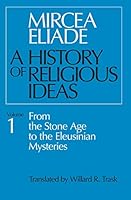# History of Religious Ideas, Volume 1

## Metadata
- Author: [[Mircea Eliade]]
- Full Title: History of Religious Ideas, Volume 1
- Category: #books
## Highlights
- “every innovation brought with it the danger of collective death” (André Varagnac). ([Location 349](https://readwise.io/to_kindle?action=open&asin=B00IGQI7OQ&location=349))
- The domestication of fire—that is, the possibility of producing, preserving, and transporting it—marks, we might say, the definitive separation of the Paleanthropians from their zoological predecessors. ([Location 350](https://readwise.io/to_kindle?action=open&asin=B00IGQI7OQ&location=350))
- Hunting determined the division of labor in accordance with sex, thus reinforcing “hominization”; for among the carnivora, and in the entire animal world, no such difference exists. ([Location 360](https://readwise.io/to_kindle?action=open&asin=B00IGQI7OQ&location=360))
- To kill the hunted beast or, later, the domestic animal is equivalent to a “sacrifice” in which the victims are interchangeable. ([Location 365](https://readwise.io/to_kindle?action=open&asin=B00IGQI7OQ&location=365))
- the experience of the sacred constitutes an element in the structure of consciousness. ([Location 371](https://readwise.io/to_kindle?action=open&asin=B00IGQI7OQ&location=371))
- The first technological discoveries—the transformation of stone into instruments for attack and defense, the mastery over fire—not only insured the survival and development of the human species; they also produced a universe of mythico-religious values and inspired and fed the creative imagination. ([Location 388](https://readwise.io/to_kindle?action=open&asin=B00IGQI7OQ&location=388))
- It is, above all, mastery over distance, gained by the projectile weapon, which gave rise to countless beliefs, myths, and legends. ([Location 393](https://readwise.io/to_kindle?action=open&asin=B00IGQI7OQ&location=393))
- Belief in a survival after death seems to be demonstrated, from the earliest times, by the use of red ocher as a ritual substitute for blood, hence as a symbol of life. ([Location 442](https://readwise.io/to_kindle?action=open&asin=B00IGQI7OQ&location=442))
- To sum up, we may conclude that the burials confirm the belief in survival (already indicated by the use of red ocher) and furnish some additional details: burials oriented toward the East, showing an intention to connect the fate of the soul with the course of the sun, hence the hope of a rebirth, that is, of a postexistence in another world; belief in the continuation of a specific activity; certain funeral rites, indicated by offerings of objects of personal adornment and by the remains of meals. ([Location 469](https://readwise.io/to_kindle?action=open&asin=B00IGQI7OQ&location=469))